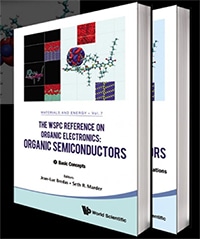Jul 26 2016
Organic carbon-based materials are increasingly exploited as active elements in electronic devices. A major example, representing a multi-billion dollar industry already, is the field of organic light-emitting diode (OLED) displays currently found in top-of-the-line smart phones and televisions - apart from which many other areas are also application-targets for electrically and optically active organic materials.
 Cover for "WSPC Reference on Organic Electronics." (Credit: World Scientific)
Cover for "WSPC Reference on Organic Electronics." (Credit: World Scientific)
In the WSPC Reference on Organic Electronics, world-renowned researchers share their basic understanding of the foundational concepts pertaining to the design, synthesis, and applications of conjugated organic materials. These materials are used as semiconductors in new generations of devices for printed, conformable, and wearable electronics, in the context of applications related to light-emitting diodes, solar cells, field-effect transistors, spintronics, actuation, bioelectronics, thermoelectrics, and nonlinear optics.
This two-volume set emphasizes on both the fundamental chemistry and physics concepts underlying the field of organic semiconductors, and how these concepts drive a broad range of applications; making the volumes ideal introductory textbooks in the subject.
"When planning this book, our goal was to provide an introduction to the field of organic electronics and photonics to early career scientists and engineers, and at the same time include chapters with sufficient depth and rigor to make the two volumes useful for more senior researchers," said co-editors Seth Marder and Jean-Luc Bredas, "Thus, we carefully selected a cast of authors, not only recognized for their seminal research contributions to the field, but also known to be excellent teachers as well."
The WSPC Reference on Organic Electronics offers great value to both junior and senior scientists working in areas ranging from organic chemistry to condensed matter physics and materials science and engineering.
"I was hoping for a long time that a comprehensive book on Organic Semiconductors that emphasizes their applications would be published for the benefit of undergraduate students, graduate students, postdocs, and junior scientists. This two-volume series is that book", comments Valy Vardeny, lead author of the chapter on spintronics.
John Reynolds, lead author of the chapter on conducting polymers, adds: "The field of conjugated materials for organic electronic applications has developed to the point that students and new researchers to the area have to be brought up to speed on the many necessary fundamental concepts that must be grasped. As a teaching and learning tool, this set of books brings just what the uninitiated, and those wanting to broaden their horizons, need."
Over twenty of the world leaders in the field of organic electronics and their co-workers, coming from top institutions in the US, Asia, Europe, and Australia, have contributed to this two-volume set.
WSPC Reference on Organic Electronics (in 2 volumes) retails at introductory offer of US$495 / £411, and is available through the publisher, Amazon, Barnes and Noble, and many other book stores, libraries, and technical reference suppliers. The introductory offer is valid until Oct 31, 2016. To know more about the book visit http://www.worldscientific.com/worldscibooks/10.1142/9678